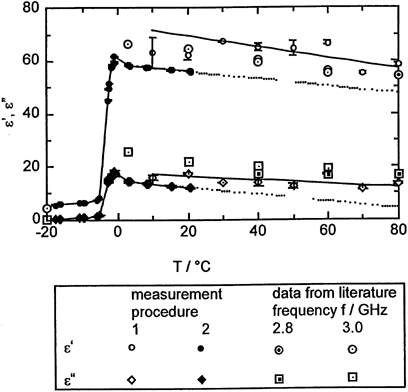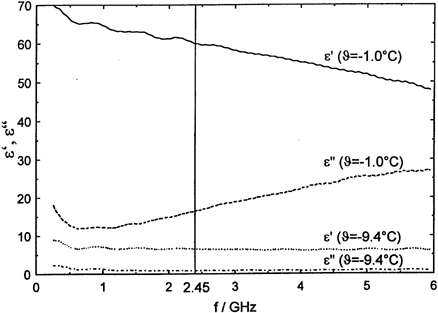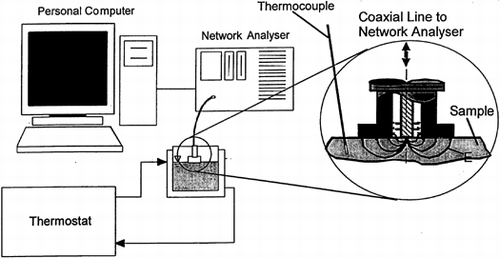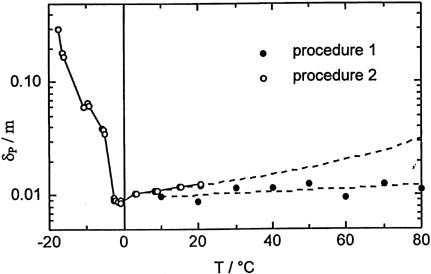Abstract
The dielectric properties of mashed potatoes are measured as a function of sample temperature and preparation procedure. The temperature range for the first sample is between 10 and 80°C, the second sample is characterised in the temperature range from −17.7 to 20.7°C. The results show, that the impact of temperature on the dielectric properties at 2.45 GHz is small in the range above the freezing temperature. In the temperature range, where melting occurs, there is a sharp increase of the relative dielectric constant ε′ and the loss factor ε′′. The measured, inter- and extrapolated values of the dielectric properties are used to calculate the penetration depth δ p . This parameter can serve as an input parameter for the mathematical modelling of temperature profiles in microwave heating of food of cylindrical and slab-shaped geometry.
INTRODUCTION
In microwave heating experiments mashed potatoes are often used as model substances, because of the simple preparation of samples of constant chemical composition and homogeneous structure Citation[1]. In earlier works Citation2-3 mashed potatoes serve as experimental verification material of simple mathematical models, for the prediction of temperature distributions and local heating rates in semi-solid foods of cylindrical and slab-shaped geometry, heated by microwaves. The basic physical material parameters for microwave heating are the dielectric properties (ε′, ε′′or δ p ). According to a sensitivity analysis of the mathematical models for temperature distribution predictions in solid food heated by microwaves Citation4-5, the accuracy of the used dielectric properties strongly influences the prediction of local temperatures of the heated sample, for example the shape of the temperature profile or the extremal temperatures Citation[3], Citation[5].
In the related literature, some dielectric properties of mashed potatoes are given (Citation6-7 – experimental data, Citation8-10 – compiled data). The available measurements (and therefore the validity of individual published values) are limited mostly to a certain microwave frequency, to certain water contents and temperatures of the material. The use of published data to predict the heating process, that is governed by different material parameters, which additionally are dependent on frequency, the moisture and the temperature of the heated material, strongly disturbs the precision of the prediction. Therefore, the aim of this work is to measure the dielectric properties of mashed potatoes, which correspond to the exact experimental conditions Citation2-3, in order to verify the model predictions.
MATERIAL AND METHODS
Sample Preparation
The samples for the measurement of dielectric properties are prepared using a dried semi-product (producer: Naturamyl, joint stock company, Pohledsti Dvoraci, local producer Bohdalov, Czech Republic). The dried mashed potatoes are added to the mixture of cold water and boiling water and are carefully stirred for 1 min at slow and 1 min at medium speed (using a food hand mixer). The used masses are: 300 g dried mashed potatoes, 800 g cold water, and 1200 g water at boiling temperature. Two different preparation methods are used prior to the dielectric characterisation:
| 1. | the sample of mashed potatoes is dielectrically measured, directly after mixing, | ||||
| 2. | the sample is previously evacuated for 5 min at an absolute pressure of 0.1 bar. The evacuation procedure is done in a shallow dish with dimensions of 100 × 120 mm. The resulting height of the mashed potatoes layer is 40 mm. | ||||
The composition and its maximum relative error of the samples of mashed potatoes used for the measurement of dielectric properties are shown in Table .
Table 1. Composition of Samples of Mashed Potatoes According to a Chemical Analysis
Method of Measurement of Dielectric Properties
In order to measure dielectric properties of relatively homogeneous samples in a certain temperature range, a suitable method is the open ended coaxial line reflectory probe. This device uses the complex reflection coefficient (measured by a network analyser) of the system consisting of the probe and the contacted sample, to determine its complex dielectric constant. A commercial system (Hewlett Packard HP85070b) is used with its standard calibration procedure with air, a metallic shorting block and water as test materials. The measurable frequency range of the set-up is from 200 MHz to 6 GHz. For the microwave heating application, especially in domestic ovens, exclusively the frequency of 2.45 GHz is used; therefore the permittivity at this frequency is the most interesting one for microwave heating simulations.
The set-up is shown in Figure . A personal computer controls the reflection coefficient measurements of a network analyser and calculates the complex dielectric constants. The network analyser is coupled by a coaxial line to the probe, that is in direct contact with the sample to be characterised. The temperature of the sample is controlled by an oil bath, which surrounds the sample-probe system. Nevertheless, in order to avoid inaccuracies, the temperature close to the dielectric probe is independently measured by a thermocouple. Whereas for sample 1, which is dielectrically characterised at temperatures well above the freezing point, measurements at three different locations in the sample could be taken, due to its soft consistence, sample 2 is frozen together with the calibrated probe. Therefore, in procedure 1 the measurement error bars consist of both, the reproducibility of the probe and the inhomogenity of the sample. In sample 2, only three measurements at the same sample location are possible, leading to smaller error bars, that show only the reproducibility of the dielectric probe. The resulted reproducibility bars Δε′/ε′ < 1.5% and Δ(ε′′/ε′) < 0.025 reasonably fit to the values from the probe producer Citation[11]. The size of the overall error bars (for procedure 1) Δε′/ε′ < 9.5% and Δ(ε′′/ε′) < 0.045 show, that they are mainly governed by the sample inhomogenity. High water losses during the measurements are prevented by a lab foil, covering the sample surface, so that the maximum weight loss due to water evaporation is less than 1%.
RESULTS AND DISCUSSION
The results of the permittivity measurements at 2.45 GHz are shown in Figure for both samples. Below − 3°C the values of both ε′ and ε′′ are rather small (approximately 5 to 9 and 0.1 to 2, respectively). For the thawing experiment (procedure 2) the phase transition of water from ice to water takes place at a temperature of approximately −3°C, due to the dissolved ingredients. The values of the permittivity show a maximum at ca. 0°C (approximately 62 and 17, respectively), before they slightly decrease with increasing temperature.
Figure 2. Data from literature (Datta, Sun, and Solis, 1995) and measured values of mashed potatoes together with inter- and extrapolated lines to guide the eye.

Comparing the values of the two sample production procedures, the values of procedure 2 are notably smaller than those of procedure 1. This can be explained by the water loss during the evacuation, since the dielectric properties at 2.45 GHz of mashed potatoes are strongly governed by the water relaxation, what is shown for two representative examples of the frequency dependent permittivity in Figure . The ion conductivity only plays a certain role at lower frequencies up to approximately 800 MHz.
Figure 3. Frequency dependency of the permittivity of mashed potatoes at temperatures below and above the water phase transition.

A significant decrease with increasing temperature up to 25°C of the dielectric properties can be observed for the sample of procedure 2. The sample heterogeneity is responsible for the scattering of the experimental data that superposes the expected decrease of the measured complex permittivity values (e.g. Citation[6]) of the sample of procedure 1 at higher temperatures. Nevertheless the right tendency can be shown by calculating a linear regression line. The slope of this regression approximately fits to the more precisely defined extrapolation of the permittivity of sample 2. The corresponding fit parameters are listed in Table together with their uncertainties. This empirical correlations make it possible to calculate permittivities also at intermediate temperatures, used for model calculations.
Table 2. Fit Parameters for the Linear Regression  in Figure
in Figure
Also shown in Figure are permittivity values from literature Citation[9]. The discrepancies to our measured data can be explained by the different sample composition and different frequencies. With the values of the complex permittivity the power penetration depth, which is defined by the distance within a semi-infinite, lossy dielectric material, that a plane wave has to propagate before its power density is reduced by 1/e, can be calculated by Eq. Equation1.
Also in Figure , which shows the calculated power penetration depth, the phase transition of water is visible as the minimum of the curve. Whereas at lower temperatures the penetration depth starts at 300 mm, it is drastically reduced down to 8.5 mm, before it remains relatively constant at values of approximately 10 to 12 mm at higher temperatures (procedure 1). This value reasonably corresponds to results of earlier model calculations Citation[5]. The penetration depth of procedure 2, which is calculated by the use of the extrapolation of the permittivity of Figure seems to increase with the temperature.
CONCLUSIONS
Dielectric properties (ε′ and ε′′) of the mashed potatoes are measured in the temperature range of −17.7°C to 80°C. The samples are prepared in accordance with procedures, that are used in heating and thawing experiments made in FRI Prague. Two different procedures of preparation are used – with and without evacuation prior to the measurement.
The measurement of dielectric properties with an open ended coaxial line reflectory probe provides satisfactory results. The measured values of ε′ and ε′′ are influenced by the sample preparation. They depend on the sample temperature and the frequency. Besides, the dielectric properties of mashed potatoes show a clear evidence of the melting of ice in the sample. The differences between the results of different sample preparation procedures are mainly caused by the loss of water during evacuation. This is supported by a composition analysis. The penetration depth δ p , which is calculated from measured and inter- and extrapolated data of ε′ and ε′′, changes slightly in the temperature range above the initial melting point. The mean value of this parameter is approximately 12 mm, which corresponds to results of mathematical modelling calculations and measured local time temperature dependencies during the heating of mashed potatoes in the microwave oven (modelling and experiments done in FRI Prague, Citation[5]).
NOMENCLATURE
| b | = |
fit parameter: axis intercept (−) |
| c | = |
vacuum speed of light (m/s) |
| f | = |
frequency (1/s) |
| m | = |
fit parameter: slope (−) |
| δ P | = |
penetration depth (m) |
| ε′ | = |
relative dielectric constant (−) |
| ε″ | = |
relative dielectric loss factor (−) |
| ϑ | = |
temperature (°C) |
ACKNOWLEDGMENT
This work was supported by the grant EP-6260 Ministry of Agriculture of the Czech Republic. The authors acknowledge also the encouragement provided by Prof. Dr.-Ing.habil. Helmar Schubert and Dr. Milan Houska.
REFERENCES
- Burfoot , D. , Railton , C. J. , Foster , A. M. and Reavell , S. R. 1996 . Modelling the Pasteurisation of Prepared Meals with Microwaves at 896 MHz . Journal of Food Engineering , 30 : 117 – 133 .
- Housova , J. , Hoke , K. and Topinka , P. Modelling of Temperature Distribution in Materials of Simple Geometry Heated by Microwaves . Proceedings of Conference Modelling of Thermal Properties and Behaviour of Foods during Production, Storage and Distribution . pp. 43 – 50 . Prague
- Housova , J. , Hoke , K. and Topinka , P. 1999 . Temperature Distribution in a Layer of Food Heated by Microwaves . Czech J. Food Sci , 16 : 179 – 188 .
- Lin , Y. E. , Anantheswaran , R. C. and Puri , V. M. 1995 . Finite Element Analysis of Microwave Heating of Solid Foods . Journal of Food Engineering , 25 : 85 – 112 .
- Housova , J. and Hoke , K. Temperature Profiles in Microwave Heated Solid Foods of Slab Geometry: Influence of Process Parameters . (Prepared for Publication in Czech Journal of Food Sciences, 2000.) ,
- Bengtssson , N. E. and Risman , P. O. 1971 . Dielectric Properties of Food at 3 GHz as Determined by a Cavity Perturbation Technique . J. Microwave Power , 6 : 409 – 429 .
- Risman , P. O. , Ohlsson , T. and Lingnert , H. 1993 . Model Substances and their Use in Microwave Heating Studies . SIK-Rapport , Nr. 588, Göteborg
- Kent , M. 1987 . Electrical and Dielectric Properties of Food Materials London : Science and Technology Publishers .
- Datta , K. A. , Sun , E. and Solis , A. 1995 . “ Food Dielectric Property Data ” . In Engineering Properties of Food , 2nd Ed. Edited by: Rao , M. A. and Rizvi , S. S.H. 457 – 494 . New York : Marcel Dekker Inc. .
- Ryynänen , S. 1995 . The Electromagnetic Properties of Food Materials: A Review of the Basic Principles . Journal of Food Engineering , 26 : 409 – 429 .
- 1993 . Hewlett Packard: HP85070B Quick Reference

